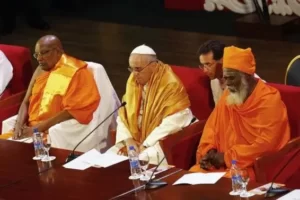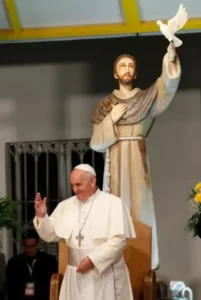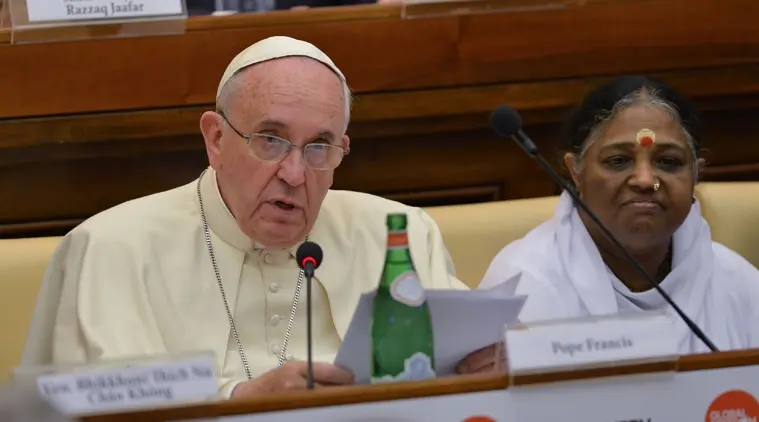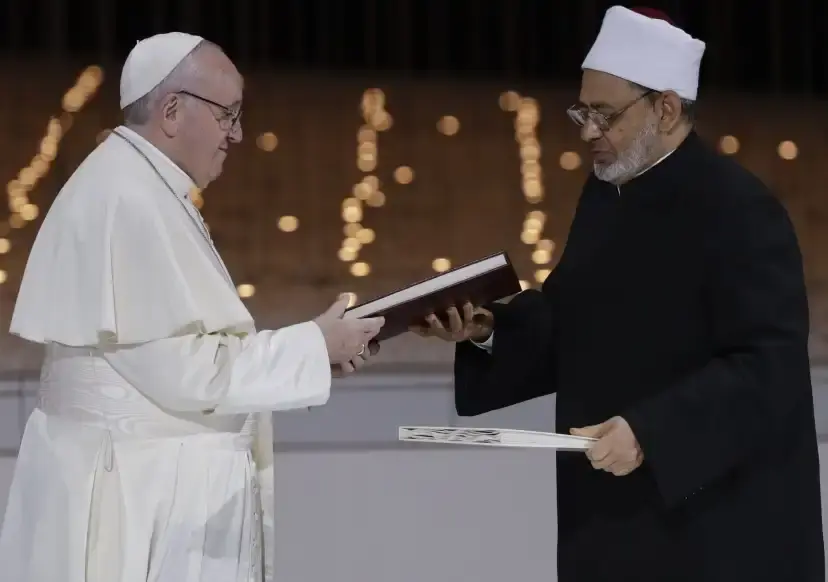 On March 13, 2013, Jorge Mario Bergoglio became Pope Francis, the 266th pontiff of the Catholic Church. He was the first pope from the Americas, the first from the Southern Hemisphere, the first Jesuit, and the first to choose the name Francesco in honor of St. Francis of Assisi (1181 – 1226). He was named Person of the Year by Time magazine in 2013 and was nominated for the Nobel Peace Prize the following year. Here, we look to Pope Francis’ interfaith works.
On March 13, 2013, Jorge Mario Bergoglio became Pope Francis, the 266th pontiff of the Catholic Church. He was the first pope from the Americas, the first from the Southern Hemisphere, the first Jesuit, and the first to choose the name Francesco in honor of St. Francis of Assisi (1181 – 1226). He was named Person of the Year by Time magazine in 2013 and was nominated for the Nobel Peace Prize the following year. Here, we look to Pope Francis’ interfaith works.
Francis:
Many people wanted to know why the Bishop of Rome wished to be called Francis. Some thought of Francis Xavier, Francis De Sales, and also Francis of
Assisi.
Pope Francis tells,
During the election, I was seated next to the Archbishop Emeritus of Sao Paolo and Prefect Emeritus of the Congregation for the Clergy, Cardinal Claudio Hummes: a good friend, a good friend! When things were looking dangerous for me, he encouraged me.
And when the votes reached two thirds, there was the usual applause (by the Cardinals in conclave), because a Pope had been elected. And he gave me a hug and a kiss and said: ‘Don’t forget the poor!’ And those words stuck with me: the poor, the poor. Then, right away, thinking of the poor, I thought of Francis of Assisi. Then I thought of all the wars, as the votes were still being counted, till the end. Francis is also the man of peace. That is how the name came into my heart: Francis of Assisi. For me, he is the man of poverty, the man of peace, the man who loves and protects creation … He is the man who gives us this spirit of peace, the poor man … How I would like a Church which is poor and for the poor!”
Consequently, the goals that Pope Francis will set for his pontificate are closely linked to this trilogy: poverty, peace, care for creation.

Following in the footsteps of the saint of Assisi, Pope Francis has been a veritable apostle of dialogue without borders, as his journeys to the tour corners of the world have shown. Among the most significant are those to Israel and Palestine, Egypt, the United Arab Emirates and Iraq, Japan, Myanmar, and Bangladesh—all predominantly non-Christian countries—Cuba, the United States of America, the Central African Republic, Nairobi, and Uganda, where he met with representatives of other faiths. As Pope Francis himself explains it, his relationship with Jews began when he was the Archbishop of Buenos Aires. “Our relationship is very close to my heart; back in Buenos Aires, I used to go to the synagogues and meet with communities gathered there. I would follow the Jewish festivals and commemorations and give thanks lo the Lord, who gives us life and who accompanies us throughout history. . . . In interreligious dialogue it is fundamental that we encounter each other as brothers and sisters before our Creator and that we praise him; and that we respect and appreciate each other and try to cooperate.
Ahmed el-Tayeb, Grand Imam of al-Azhar and president of Egypt’s Al-Azhar University, sent congratulations after the pope’s election. Al-Tayeb had “broken off relations with the Vatican” during Benedict XVI’s time as pope; his message of congratulations also included the request that “Islam asks for respect from the new pontiff”.
Shortly after his election, in a meeting with ambassadors from the 180 countries accredited with the Holy See, Pope Francis called for more interreligious dialogue – “particularly with Islam”. He also expressed gratitude that “so many civil and religious leaders from the Islamic world” had attended his installation Mass. An editorial in the Saudi Arabian paper Saudi Gazette strongly welcomed the pope’s call for increased interfaith dialogue, stressing that while the pope was “reiterating a position he has always maintained”, his public call as pope for increased dialogue with Islam “comes as a breath of fresh air at a time when much of the Western world is experiencing a nasty outbreak of Islamophobia”.

In 2016, Pope Francis met with Ahmed el-Tayeb at the Vatican, the first meeting since 2000 between the Grand Imam of al-Azhar and the leader of the world’s Catholics.
On 3 February 2019, Francis visited the Arabian Peninsula on a trip to Abu Dhabi, United Arab Emirates. During the visit he met Grand Imam of al-Azhar Ahmed el-Tayeb and held papal Mass to more than 120,000 attendees in the Zayed Sports City Stadium. Pope Francis also signed, alongside the Grand Imam, the Document on Human Fraternity for World Peace and Living Together, a document which pledges world peace and living together between people of different faiths.

Document for Human Fraternity for World Peace and Living Together
“The Document for Human Fraternity for World Peace and Living Together, signed by the Pope of the Catholic Church, Francesco, and by Shaykh Ahmed al-Tayyeb, imam of the Al-Azhar mosque, along with the journey of the Pope to the United Arab Emirates, is an unprecedented event, at an institutional level, in the history of relations between Christians and Muslims. [..]The general impression is that a new phase is opening, under many aspects, with regards to the relations between these two religions. This phase seems to be moving toward the recognition of the legitimacy, and providence, of the diversity of the Revelations, of theologies, of religions, of languages, and of religious communities. Diversities are no longer being seen as a call to conquest or proselytism, or as an excuse for a mere facade of tolerance, but rather recognised as an opportunity for the exercise and practice of fraternity that represents a vocation contained in God’s plan of creation”. See the summary of this document
Thereafter you can find the proceedings of this meeting and Fraternity for knowledge and cooperation the commentary on the official document, which has been signed by Muslim religious leaders, celebrities and representatives from all around the world.
Pope Francis observes,
“The different religions, based on their respect for each human person as a creature called to be a child of God, contribute significantly to building fraternity and defending justice in society. Dialogue between the followers of different religions does not take place simply for the sake of diplomacy, consideration or tolerance. In the words of the Bishops of India, ‘the goal of dialogue is to establish friendship, peace and harmony, and to share spiritual and moral values and experiences in a spirit of truth and love.”’
![]()

